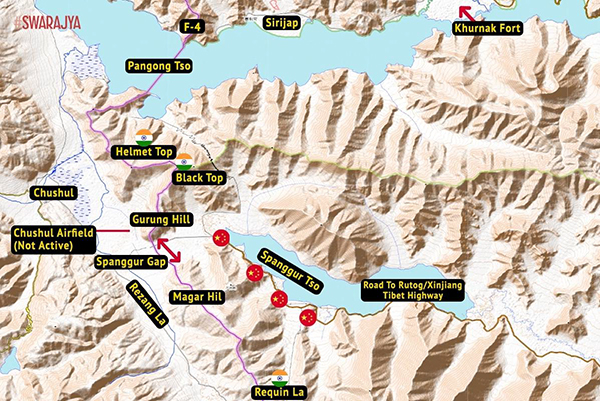The Western Front
On the Ladakh front, China had managed to surprise India by its sudden moves in May this year. Due to Covid pandemic, the Indian Army had not held its seasonal exercise in Eastern Ladakh to keep a watch on Chinese military exercises that are held opposite, usually in March-April. The Chinese had moved down their 4th Highland Motorized and 6th Mechanized divisions some 1000 kms from Xinjiang. Elements of these formations suddenly made a dash in civilian vehicles to some five “friction spots” on the Line of Actual Control (LAC). Specifically, they tried to intrude into Daulat Beg Oldi (DBO), Depsang, Hot Springs , Galwan river valley and north of Pongong Tso in the Fingers area. They were now posing a direct threat to India’s newly constructed Darbuk-Shyok-DBO highway.
India counter-mobilized rapidly and soon had matched the Chinese force deployments tank for tank, gun for gun and soldier for soldier. This rapid mirror imaging of force levels surprised China. It started military-to-military talks for disengagement. Even as these talks were on, on 15 June, China staged a ghastly incident in the Galwan river valley using iron rods, baseball bats wound with barbed wire, knives and stones to kill 20 Indian soldiers. The retaliation was sharp but confined to the primitive level and the estimate of Chinese casualties varies from 35-60 killed. China refused to divulge any figures. This lethal clash had, in effect, junked the 1993 and 1996 Peace & Tranquility accords.
ALSO READ: Army strengthens dominance in over 20 strategic heights
India has now clearly put the PLA on notice that any attempt to repeat the Galwan tamasha will invite armed retaliation. Meanwhile, India rapidly built up its logistical stocks in the area and inducted additional troops, who were systematically acclimatised and readied for operations in this terrain.
India’s response options were basically threefold:-
• Launch kinetic operations to physically evict Chinese soldiers from the friction areas.
• Counter-ingress in the same region and seize tactically vital terrain in a pre-emptive manner.
• Counter ingress in another faraway theatre of operations.
By August-end India’s logistical stocking and troops build-up was completed. it chose to exercise the counter-ingress model by using its Special Frontier Force (SFF) elements and 17 Corps formations to rapidly occupy the heights in the strategically vital Pongong Tso South area. This is the traditional invasion route into Tibet and Ladakh and was first used by the Dogra General Zorawar Singh in 1841, when he Invaded Tibet and captured the sacred Mt Kailash and Mansarovar lake area. This pre-emptive offensive took the Chinese by complete surprise. In a swift move the Indians secured Black Top, Helmet Top, Magar Hill, Gurung Hill, Rezang La and Rechin La heights on the Kailash range, which dominates the traditional invasion route of the Spanggur Gap and the Chushul bowl which leads to Leh. They had secured the heights that would facilitate a major offensive into Western Tibet to cut the Chinese G-219 highway linking Xinjiang to Tibet. These heights completely overlooked the massive Chinese garrison at Moldo. The Chinese were dazed. Talks at the defence ministers level proved inconclusive in Moscow. However, just two days later, the two foreign ministers talked at length and put out five inane sounding points that seemed to reiterate provisions of the now defunct 1993 and 1996 peace accords. A little oversight that seemed forgotten was the ghastly incident at Galwan. Both sides now seemed to be settling down for a long winter ahead and, perhaps, many more such winters in the years to come. The tables had been fully turned on the Chinese troops and India had given tit-for-tat with this surprise coup de main operation.
So what are Chinese options in the given scenario now? It can either launch a bloody kinetic operation to retake Black Top or one or more of these heights or intrude in some other sector. Otherwise, it has to settle down for the long haul in Eastern Ladakh. All in all, the Chinese have cut a somewhat sorry figure for all their propaganda broadcasts and bravado. This bluff has largely been called but may need underlining with limited kinetic action for inducing future deterrence.
Taiwan Straits Heating Up
On 9 and 10 September, some 30 Chinese Peoples Liberation Army Air Force (PLAAF) fighters were exercising with the PLA Navy warships in the straits of Taiwan. They suddenly made forays across the midline, which has served so far as an unofficial buffer zone and is the limit of Taiwan’s Air Defence Identification Zone (ADIZ). When challenged by Taiwan Air Force fighters for having crossed the middle line, the China replied that there was no middle line anymore. Taiwan’s ADIZ has been breached and forcibly redefined. Such creeping efforts to alter the status quo have been the hallmark of very aggressive and provocative Chinese behaviour all along its periphery – in the East China Sea, Taiwan Straits, South China Sea (SCS) and then in the western theatre against India.
China has also been rehearsing amphibious landings on the Hainan Islands to simulate an assault on the Taiwan-held Dongsha Island in the SCS. The Chinese Global Times has been threatening that this could turn to actual and swiftly become a new invasion. Is conflict imminent in the Taiwan Straits and SCS?


















